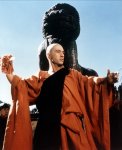Tuzenbach
First Post
There was a point in time where I remember associating the medieval/fantasy "monk" with this......

(....or similar 1938 "Robin Hood" Friar Tuck stereotype.....)
Since D&D came out, however, my association has changed to this.......

In terms of verisimilitude, which is a more faithful representation of the monk? Perhaps a combination of the above? Perhaps neither of the above? Are there real world monks today who actually practice martial arts? Discuss!!!!

(....or similar 1938 "Robin Hood" Friar Tuck stereotype.....)
Since D&D came out, however, my association has changed to this.......

In terms of verisimilitude, which is a more faithful representation of the monk? Perhaps a combination of the above? Perhaps neither of the above? Are there real world monks today who actually practice martial arts? Discuss!!!!
